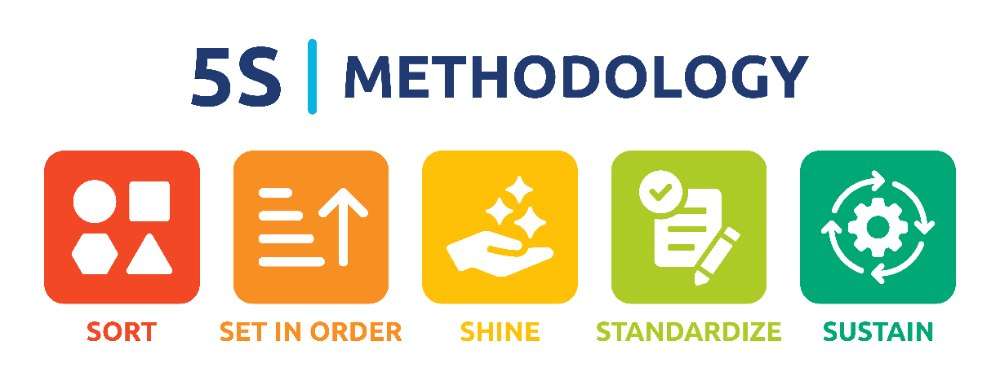In manufacturing, businesses constantly seek ways to improve productivity and reduce errors. One method that has proven to be effective is implementing a 5S program. 5s focuses on workplace organization and efficiency. However, a key to maintaining a successful 5S program is conducting regular 5S audits. These audits reveal hidden challenges and reinforce the necessary behavioral changes in the workforce to sustain a well-organized and efficient work environment. This blog will review how 5s audit can streamline work operations. Let’s dive in!
Understanding The 5S Framework
The 5S framework, initially developed in Japan, provides five critical steps for maintaining an efficient workspace: Sort, Set in order, Shine, Standardize, and Sustain. Take a look at how these steps are broken down:

1. Sort
The first step in the 5S framework is to sort through tools, equipment, furniture, and other items in an area. After this, made a list of what should need to be kept and what should be removed from the site.
This process helps eliminate unnecessary clutter and ensures that only essential items are present in the work environment.
2. Set In Order
Once the sorting process is complete, it is essential to organize the remaining items and decide how they will be stored.
This step involves creating a designated place for each item, labeling storage areas, and ensuring everything is easily accessible and identifiable.
3. Shine
Maintaining cleanliness and orderliness is crucial in the workplace. The shine step emphasizes the regular cleaning and maintenance of work areas and equipment.
Proactively cleaning and performing maintenance tasks can identify and address potential hazards and reduce the risk of accidents and breakdowns.
4. Standardize
Standardizing processes helps eliminate variations and ensures that everyone follows the same procedures.
It involves creating clear guidelines and protocols for sorting, organizing, cleaning, and maintaining the work environment.
5. Sustain
Sustaining involves ongoing monitoring, regular audits, and reinforcing the importance of following the 5S principles.
It requires commitment from all levels of the organization to maintain orderliness and cleanliness.
Now that we understand the 5s framework, let’s begin our main topic, the 5s Audit.
What Is 5s Audit?
A 5S Audit comprehensively evaluates workplace cleanliness, organization, and standardization. The audit is designed to identify areas that require improvement and measures to achieve optimal productivity, efficiency, and safety.
Moreover, the audit examines current procedures and work habits to streamline processes, reduce waste, and increase efficiency.
For example, a 5S Audit of a manufacturing plant might evaluate
- If all tools have dedicated storage spots?
- Every operation has standardized work instructions
- Is there any clutter or debris on the work floor that may pose an accident risk?
The Importance Of 5S Audits
By conducting regular audits, businesses can:
1. Reveal Hidden Challenges

5S audits are not just visual inspections; they are comprehensive analyses of work processes and the ability to produce quality products.
Audits help identify hidden challenges and potential issues before developing into larger, more problematic ones.
By uncovering these challenges, businesses can proactively address them and prevent future complications.
2. Boost Safety And Reduce Risks

Maintaining a safe work environment is of utmost importance in any industry. 5S audits help identify potential safety hazards, such as obstructions, spills, or equipment malfunctions.
By addressing these issues promptly, businesses can prevent accidents, reduce the risk of injuries, and create a safer workplace for their employees.
3. Improve Productivity And Efficiency

A well-organized and efficient work environment is essential for maximizing productivity. 5S audits help identify opportunities to streamline processes, eliminate waste, and improve workflow.
By implementing the suggested improvements from the audits, businesses can reduce production and machine failures, cut process time, and enhance overall efficiency.
4. Support Continuous Improvement
Conducting 5S audits creates a continuous improvement cycle within the organization. The audits provide valuable insights into the effectiveness of the 5S practices and highlight areas that require further attention or improvement.
By regularly reviewing audit results and implementing necessary changes, businesses can continuously enhance their work environment and optimize their processes.
5. Foster Employee Engagement And Ownership

Involving employees in the 5S audit process fosters a sense of ownership and accountability.
When employees actively participate in audits and contribute their ideas and feedback, they become more committed to maintaining a clean and organized work environment.
This increased engagement leads to higher employee morale and shared responsibility for workplace organization.
How To Conduct Successful 5s Audits?
To ensure the effectiveness of 5S audits, businesses should follow these tips:

1. Conduct Audits Regularly
Doing audits regularly will boost the results. Make audits a priority and assign specific individuals or teams to perform the inspections. Audits can be done in three ways:
- Weekly Audits: Weekly audits are highly recommended, allowing teams to review their areas and perform self-checks of their work environment.
- Monthly and quarterly audits: Such audits are performed by supervisors or plant managers. It provides additional oversight and ensures compliance with 5S principles.
2. Conduct Random Audits
It is essential to conduct audits randomly without giving prior notice to obtain accurate assessments of the work environment.
The goal is to analyze the area in its normal state to identify any ongoing issues or areas for improvement. Thus, avoid posting an audit schedule, which may lead to superficial cleaning just before the inspection.
3. Involve People From Other Departments
To gain a fresh perspective and promote objectivity in scoring, involve people from other departments in the audit process.
Having individuals from different areas of the organization perform audits together allows for knowledge sharing and cross-departmental collaboration.
It also strengthens the credibility of the audit results and encourages a broader understanding of 5S principles.
5. Review The Audit Results With The Group
After conducting audits, reviewing the results and action items with the audited group is crucial.
This feedback session provides an opportunity to discuss the strengths and weaknesses observed during the audit, solicit ideas for improvement, and encourage open communication.
Businesses can foster collaboration and collective ownership of maintaining a well-organized work environment by involving the entire team in the review process.
The 5S Audit Checklist
To ensure a comprehensive evaluation of each department, businesses can utilize 5S audit checklists. The checklist should cover the following areas:
Sort
- Are there any unnecessary materials or machine parts around?
- Are there any unused machines or other equipment taking up space?
- Are only job-related documents stored in the work zone?
Set In order
- Are shelves and storage areas clearly labeled with location indicators?
- Are all items in their designated places except for those currently in use?
- Are clear lines or markers used to indicate walkways and storage areas?
Shine
- Are floors and pieces of equipment kept clean and free from waste, dust, and oil?
- Is it clear who will be taking the cleaning responsibility?
- Do employees switch off lights and clean their desks without even being asked?
Standardize
- Was the 5S audit completed for this area last month and the month before?
- Are improvement suggestions regularly generated and acted upon?
- Are standards applied uniformly across the area?
Sustain
- Are all employees adequately trained in 5S principles?
- Do you have a question?
- Are audit results and findings effectively reviewed by everyone involved?
Conclusion
5S audits are a powerful tool for maintaining a well-organized and efficient work environment. By conducting regular audits, businesses can enhance productivity and safety and foster employee engagement. Implementing a 5S checklist and leveraging digital solutions can further streamline the audit process and maximize the benefits of a robust 5S program.

